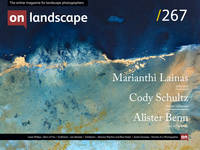Ian Meades chooses one of his favourite images

Ian Meades
Outdoorsy person and lover of strong black coffee, I first found a nascent enthusiasm for landscape photography back in the 1970s, wandering Richmond Park outside London with a Kodak 110 Instamatic. Fast forward 40 years, and I rediscovered the joys of wandering the land with a similarly diminutive camera format, this time manufactured by Olympus. I recently retired from a career in geophysics, where I spent most of my time imaging the interior of the earth. I now reside in Washington State, where I spend much of my time imaging the surface of the earth. I guess common themes thread through my life!
Tulsa, Oklahoma, is probably not the first place that springs to mind when seeking inspiration for landscape photography. Yet nestled in the Osage Hills, just a few miles from the city centre, is the Gilcrease Museum, housing an outstanding collection of art from the American West. The museum sits on 460 brushy and channelled acres that are photogenic in their own right, but in my opinion, the star exhibit is Albert Bierstadt’s oil on canvas, ‘Sierra Nevada Morning’. What’s a painting doing featured in an end frame article? I hear you protest. Well, for me, it is one of the most impactful images that I’ve experienced - either painted or photographed. Forgive my audacity, and bear with me.
Albert Bierstadt was a prolific painter, creating over 500 works across his career. He was born in Solingen, Germany, in 1830. His family emigrated to New Bedford, Massachusetts, when Albert was an infant. As a child and into his youth, he had a penchant for art, and he travelled back to Germany in 1853 to study painting at the Düsseldorf School. He returned to New Bedford in 1857, now a technically proficient painter, and taught drawing and painting for a while before committing to his own painting full-time. He focused initially on scenes from the New England area and upstate New York. He associated with the Hudson River School, with which he further developed his highly romanticised, detailed style that had its nascence during his time painting alpine scenes in Europe. Whilst Albert was developing that now famous style, his brothers, Charles and Edward, were experimenting with the rapidly advancing technology of photography and had established a small business, notably making use of stereo photography. Albert apparently collaborated with them in their efforts and found stereographs to be a useful reference tool for realistic depiction while working on his paintings.

